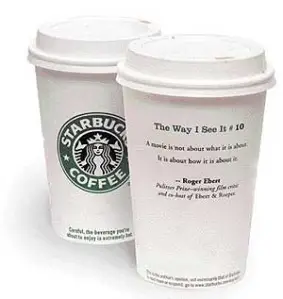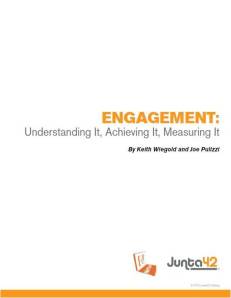 Discussions with a new client often include the evangelizing (or ‘strong advocacy’) of what Content Marketing and custom content can do for their business overall. As part of an initial presentation, I typically focus on a few that are apparent to their business/industry, but also recall from an earlier blog entry, and the list keeps growing.
Discussions with a new client often include the evangelizing (or ‘strong advocacy’) of what Content Marketing and custom content can do for their business overall. As part of an initial presentation, I typically focus on a few that are apparent to their business/industry, but also recall from an earlier blog entry, and the list keeps growing.
In the spirit of helping you evangelize the power of Content, I’m sharing a list of 20 business objectives addressed by Content Marketing.
We’ll start this week with the alphabetic first ten, beginning with A through I.
 1. Advocacy. Truly the ultimate goal for your customers – have them doing the evangelizing for your business! Even the most efficient media at the lowest CPMs can’t beat the free word of mouth by your faithful customers. And since we know customers place higher value on the recommendations of others like them (much higher than advertising) – even if they are complete strangers – word of mouth made possible by the added value of helpful, relevant content brings the power of advocacy to ultimate levels. Real bonding occurs when customers feel your business isn’t just after a sale, but all about truly helping them with solutions.
1. Advocacy. Truly the ultimate goal for your customers – have them doing the evangelizing for your business! Even the most efficient media at the lowest CPMs can’t beat the free word of mouth by your faithful customers. And since we know customers place higher value on the recommendations of others like them (much higher than advertising) – even if they are complete strangers – word of mouth made possible by the added value of helpful, relevant content brings the power of advocacy to ultimate levels. Real bonding occurs when customers feel your business isn’t just after a sale, but all about truly helping them with solutions.
2. Awareness. Normally the domain of mass media and traditional advertising, Content Marketing now easily impacts this very early stage in the customer journey  courtesy of the low cost/no cost broad channels made possible by digital media –websites, social media channels, blogging, and so on. A customer’s earliest interaction with your brand is that much more impactful when not based on interrupting their engagement with the media, but when it is actually the engaging media itself! I never would have become aware of the power of Blendtec mixers if not for their entertaining and informational video series Will It Blend? — that’s Content Marketing creating awareness.
courtesy of the low cost/no cost broad channels made possible by digital media –websites, social media channels, blogging, and so on. A customer’s earliest interaction with your brand is that much more impactful when not based on interrupting their engagement with the media, but when it is actually the engaging media itself! I never would have become aware of the power of Blendtec mixers if not for their entertaining and informational video series Will It Blend? — that’s Content Marketing creating awareness.
3. Branding. Content Marketing may possibly be the #1 WMB (weapon of mass branding) in your marketing arsenal. A “brand” (the noun) is arguably more about what your product or service stands for, rather than simply what your product or service is. And as the ultimate arbiter of what your brand really means, a customer searches for that which will serve their needs – not just the utilitarian needs of the offering, but the higher order needs of what they are ultimately seeking. Rubbermaid doesn’t just offer containers, or just ‘organization,’ but ultimately stands for a better home life experience – and that’s what their content helps brand (the verb).
 4. Churn Reduction. What reasons cause customers to leave your fold are as varied and possibly more mysterious than what incites them to stay. Chalk either up to a rewarding brand experience. More than price, more than product benefits, the ‘experience’ is an on-going and additive construct. Relevant and engaging content gives customers another reason to stay, as it serves as a differentiator from like products or services that may offer it cheaper or with a new bell or whistle. Even something as seemingly interchangeable as a household cleaner can command more loyalty when the experience reaches higher-order needs, as this inspiring content (if you’re a parent, that is) from SC Johnson shows.
4. Churn Reduction. What reasons cause customers to leave your fold are as varied and possibly more mysterious than what incites them to stay. Chalk either up to a rewarding brand experience. More than price, more than product benefits, the ‘experience’ is an on-going and additive construct. Relevant and engaging content gives customers another reason to stay, as it serves as a differentiator from like products or services that may offer it cheaper or with a new bell or whistle. Even something as seemingly interchangeable as a household cleaner can command more loyalty when the experience reaches higher-order needs, as this inspiring content (if you’re a parent, that is) from SC Johnson shows.
5. Cross-sell
‘After you got ‘em once, see if you can get ‘em again for something additional’ – that’s the basic idea behind cross-sell. The theory goes that a customer purchasing a broader swath of your product line is inherently a more profitable or at least more loyal customer. Viewed in the context of Content, it can be about a customer engaging with different content ‘platforms’ that address different customer needs. A small business owner becomes a better customer to HP if she initially is a buyer of HP ink cartridges and then begins to purchase various HP peripherals; she also becomes a better customer if she frequently engages with HP through their entrepreneur forum 367 Addison Avenue and then begins to explore content in HP’s inventor community The Next Bench. A customer experiencing a broader swath of your Content, too, is a more profitable and loyal customer.
Every time I read the phrase ‘customer acquisition,’ I envision the hackneyed sales funnel with its wide mouth atop, sloping down to a narrow aperture at the bottom, where many prospects enter and fewer customers emerge. Whether you subscribe to this clean, sequential view of customer acquisition or a messier, divergent path (compare both examples), customer acquisition begins with prospect awareness and ends with customer transaction (the continued journey toward customer retention is detailed next). Migrating prospects through these stages (or, through the funnel) is the sales challenge, with Content playing a major role in moving a prospect from awareness to consideration, consideration to interaction, interaction to transaction (or a mash-up of these steps). In fact, a strategic argument could be made that your efforts to engage via Content should increase as your suspects to prospects to customers ratios decrease.
And, the other side of the coin – now that you’ve got them, how do you keep them? Post-initial transaction efforts at re-purchase, bonding, loyalty, and advocacy can all be pegged to delivering communications that are entertaining, informational, educational, and inspirational – without being too marketer-centric (e.g. Buy me! Buy more! Buy more often!) and instead more customer-centric (e.g. By the way, By addressing my needs, right by my side). Harvard Business Review reports 91% of small business owners do nothing to retain existing clients, when even the most conservative estimates suggest the costs for new customer acquisition is five to nine times higher than the cost for retaining existing ones! Traditional advertising may have a role at the beginning of acquisition, but does relatively little in customer retention – that’s where Content truly excels!
8. In-bound marketing
The concept of in-bound marketing (versus out-bound or ‘push’ marketing) is eponymous with Content Marketing. Web 1.0 was doomed where marketers felt ‘If we build it, they will come,” and when they (customers) didn’t stay, the legacy solution was to push messages at them. In-bound marketing is centered on Content, about self-creating something interesting to say to customers about their interests. It’s the manifestation of Web 2.0, where every business has the opportunity to become ‘media.’ Think of it as a discussion at a cocktail party: if you have something interesting to say that is about delivering on the needs of a certain someone, that certain someone will flock to you. If you interrupt others’ discussions and blather on about ‘me, me, me,’ you’ll be ignored (rightfully so). Be the interesting one at the party who creates a true dialog with others. Be ‘in-bound’ Content Marketing.
9. Increase Customer LTV
Lifetime Value (LTV) is all about looking at the long-term health of a  relationship with your customer, and not about short-term, quick hit, move on to the next victim type of sale. Content helps build that elusive trust that is earned by a marketer, one that results in bonding, loyalty, and advocacy. Clearly tied to churn reduction and customer retention, LTV is actually a mind set of doing business, one based on the value of that specific person or account to one’s business. But from another angle, LTV can also be about the value of a brand or company to customer over a lifetime. As the customer’s needs change, how can the brand continue to be valuable to her? How does the brand stack up against other competitors for her time, money, commitment? Here, Content becomes a real differentiator, a competitive advantage to ensure the relationship is a long-lasting, and mutually beneficial one.
relationship with your customer, and not about short-term, quick hit, move on to the next victim type of sale. Content helps build that elusive trust that is earned by a marketer, one that results in bonding, loyalty, and advocacy. Clearly tied to churn reduction and customer retention, LTV is actually a mind set of doing business, one based on the value of that specific person or account to one’s business. But from another angle, LTV can also be about the value of a brand or company to customer over a lifetime. As the customer’s needs change, how can the brand continue to be valuable to her? How does the brand stack up against other competitors for her time, money, commitment? Here, Content becomes a real differentiator, a competitive advantage to ensure the relationship is a long-lasting, and mutually beneficial one.
10. Increase share of wallet
 The idea behind Share of Wallet typically results from both a breadth and depth of customer transactions within a given competitive set or industry. That is, increasing the share of a customer’s wallet can be through broadening what they purchase from you (capitalized on by cross-sell) or by the deepening of purchases they make with your company from a vertical perspective (capitalized on by volume purchases of the same offering and/or by trading up within the vertical…upselling). Here, Content Marketing impacts this objective by providing both information and inspiration – reassurance on past transactions and realization on future ones. LinkedIn does a great job in the subtle up-sell to their premium offering cleverly called LinkedIn Premium. For those professionals active in the job market, or those just curious, their content is user-centric and focuses on vaulting the networking hurdles and building business relationships in the digital world. Through Content Marketing, they address the higher order need for competence and control in one’s professional life, and thereby increase share-of-wallet through vertical upsell.
The idea behind Share of Wallet typically results from both a breadth and depth of customer transactions within a given competitive set or industry. That is, increasing the share of a customer’s wallet can be through broadening what they purchase from you (capitalized on by cross-sell) or by the deepening of purchases they make with your company from a vertical perspective (capitalized on by volume purchases of the same offering and/or by trading up within the vertical…upselling). Here, Content Marketing impacts this objective by providing both information and inspiration – reassurance on past transactions and realization on future ones. LinkedIn does a great job in the subtle up-sell to their premium offering cleverly called LinkedIn Premium. For those professionals active in the job market, or those just curious, their content is user-centric and focuses on vaulting the networking hurdles and building business relationships in the digital world. Through Content Marketing, they address the higher order need for competence and control in one’s professional life, and thereby increase share-of-wallet through vertical upsell.
Next time, I’ll share the second ten:
11 Integration
12 Internal communications
13 Lead generation/formulation
14 Loyalty
15 Reputation Management
16 SEO
17 Social media communications
18 Stakeholder/shareholder communications
19 Thought Leadership
20 Up-sell
Are there more that you’ve identified? Let me know — I’ll share them (and credit you) in the next post!



























